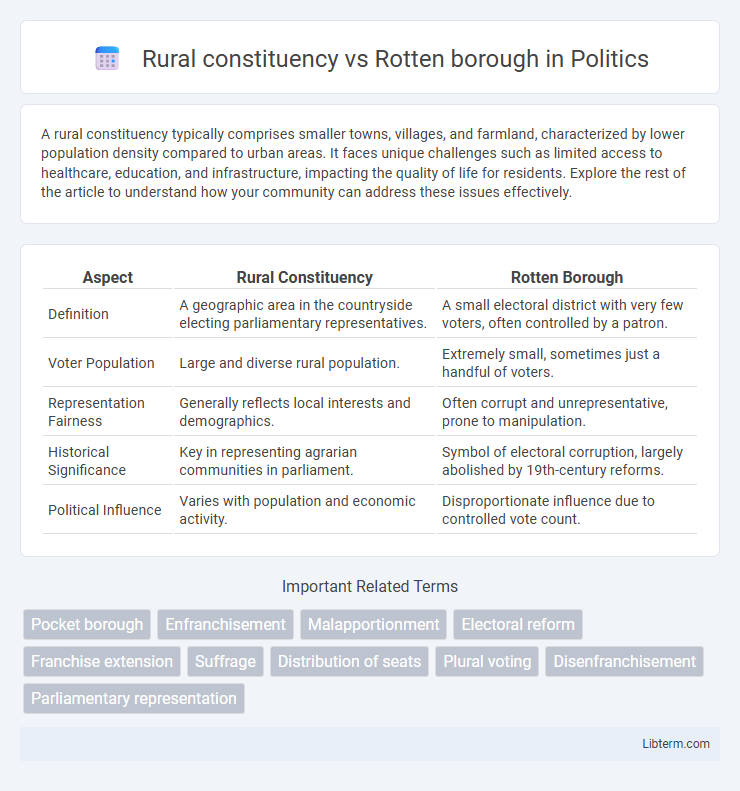A rural constituency typically comprises smaller towns, villages, and farmland, characterized by lower population density compared to urban areas. It faces unique challenges such as limited access to healthcare, education, and infrastructure, impacting the quality of life for residents. Explore the rest of the article to understand how your community can address these issues effectively.
Table of Comparison
| Aspect | Rural Constituency | Rotten Borough |
|---|---|---|
| Definition | A geographic area in the countryside electing parliamentary representatives. | A small electoral district with very few voters, often controlled by a patron. |
| Voter Population | Large and diverse rural population. | Extremely small, sometimes just a handful of voters. |
| Representation Fairness | Generally reflects local interests and demographics. | Often corrupt and unrepresentative, prone to manipulation. |
| Historical Significance | Key in representing agrarian communities in parliament. | Symbol of electoral corruption, largely abolished by 19th-century reforms. |
| Political Influence | Varies with population and economic activity. | Disproportionate influence due to controlled vote count. |
Introduction to Rural Constituency and Rotten Borough
A rural constituency refers to a geographic electoral district characterized by low population density and predominantly agricultural land use, often represented by a Member of Parliament (MP) in legislative bodies. In contrast, a rotten borough denotes a parliamentary constituency with very few voters, often controlled by a patron, leading to disproportionate and unrepresentative political influence. These historical rotten boroughs undermined democratic principles by enabling aristocratic or private control over parliamentary seats despite minimal or nonexistent populations.
Historical Context and Origins
Rural constituencies in historical parliamentary systems typically represented large, sparsely populated areas with genuine voter bases, reflecting agrarian interests and local governance. Rotten boroughs, emerging prominently before the 19th-century British reforms, were small electoral districts with very few voters, often controlled by influential landowners or patrons, leading to disproportionate parliamentary representation. The origins of rotten boroughs lie in medieval borough charters that did not account for population shifts, resulting in seats being retained despite depopulation, while rural constituencies maintained their geographic and demographic relevance.
Defining Rural Constituency
A rural constituency refers to an electoral district predominantly composed of countryside areas with low population density, reflecting agricultural communities and small villages. Unlike rotten boroughs, which were small, often depopulated constituencies manipulated for political gain, rural constituencies represent genuine geographic and demographic communities. The definition emphasizes population distribution, land use, and socio-economic characteristics intrinsic to rural regions.
Understanding Rotten Borough
A rotten borough was a parliamentary constituency in England with a very small electorate, often controlled by a single patron, allowing disproportionate influence in elections. Unlike rural constituencies representing larger, more populous areas, rotten boroughs had minimal residents but retained voting power, leading to significant electoral corruption and malapportionment. The Reform Acts of the 19th century targeted rotten boroughs to establish fairer representation by redistributing seats to emerging industrial towns.
Representation and Electoral Power
Rural constituencies typically represent larger geographic areas with dispersed populations, providing balanced electoral power aligned with population size and community interests. Rotten boroughs, often characterized by very small electorates and outdated boundaries, allow disproportionate influence to a few voters or patrons, undermining fair representation in Parliament. Electoral power in rotten boroughs is concentrated and easily manipulated, while rural constituencies aim to ensure equitable voter representation across wider regions.
Political Influence and Manipulation
Rural constituencies historically represented broader geographic areas with more dispersed populations, leading to relatively limited political influence compared to urban centers. Rotten boroughs, often tiny electorates controlled by a single patron, enabled disproportionate political manipulation and corruption, skewing parliamentary representation. This imbalance facilitated entrenched power structures, undermining democratic principles and fueling demands for electoral reform.
Demographic Differences
Rural constituencies typically represented larger, more geographically dispersed populations with predominantly agricultural economies, reflecting genuine demographic diversity. Rotten boroughs, by contrast, were characterized by very small electorates, often with just a handful of voters, and lacked proportional demographic representation, resulting in disproportionate parliamentary influence. The stark demographic differences between these two types of constituencies highlight issues of electoral fairness and political corruption in historical parliamentary systems.
Impact on Parliamentary Reforms
Rural constituencies often represented larger, more diverse populations, whereas rotten boroughs were small electoral districts with disproportionately few voters, frequently controlled by a single patron, undermining democratic representation. The existence of rotten boroughs highlighted electoral corruption and imbalance, becoming a central issue prompting the 19th-century Parliamentary reforms, such as the Reform Acts of 1832 and 1867, which aimed to redistribute seats and extend voting rights. These reforms phased out rotten boroughs and increased the political influence of rural and urban constituencies, reshaping the British parliamentary system toward greater fairness and legitimacy.
Case Studies and Notable Examples
The distinction between rural constituencies and rotten boroughs is highlighted by notable examples such as Old Sarum, a notorious rotten borough with minimal population yet disproportionate parliamentary representation before the Reform Act of 1832. In contrast, rural constituencies like East Cornwall represented large agricultural areas with growing populations, emphasizing the imbalance in representation that reformers sought to correct. Case studies reveal how rotten boroughs like Dunwich, which had almost vanished physically, continued to elect MPs, underscoring the urgent need for electoral reform in 19th-century Britain.
Lasting Legacy in Modern Politics
Rural constituencies maintain direct representation for geographically dispersed populations, ensuring local interests influence national policy despite urbanization trends. Rotten boroughs, exemplified by disproportionate electoral influence for tiny electorates, catalyzed the 19th-century reform movements leading to modern democratic principles like equal representation and electoral transparency. The lasting legacy of these contrasts shapes contemporary political structures by balancing localized representation with equitable voting rights, underpinning debates on electoral reform and constituency delineation.
Rural constituency Infographic

 libterm.com
libterm.com